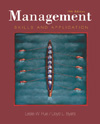 |  Management: Skills and Application, 10/e Leslie W Rue,
Georgia State University - Emeritus
Lloyd L Byars,
Georgia Institute of Technology
Understanding Work Teams
Chapter Summary| 1. Describe formal and informal work groups. Formal work groups are established by the organizing function. Their structure and membership are established and recognized by management. Informal work groups result from personal contacts and interactions of people within the organization and are not formally recognized by the organization.
2. Define group norms. Group norms are the informal rules a group adopts to regulate and regularize group members' behavior.
3. Explain group cohesiveness. Group cohesiveness refers to the degree of attraction each member has for the group, or the stick-togetherness of the group.
4. Define group conformity. Group conformity is the degree to which the members of a group accept and abide by the norms of the group.
5. Outline conditions under which individual members tend to conform to group norms. Members tend to conform to group norms when the norms are congruent with their personal attitudes, beliefs, and behavioral predispositions; when the norms are inconsistent with their personal attitudes, beliefs, or behavioral predispositions but the group exerts strong pressures to comply; and when the rewards for complying are valued or the sanctions imposed for noncompliance are devalued.
6. Define groupthink. Groupthink is a dysfunctional syndrome that cohesive groups experience that causes the group to lose its critical evaluative capabilities.
7. Understand the concept of team building. Team building is the process of establishing a cohesive group that work together to achieve its goals.
8. Explain idiosyncrasy credit. Idiosyncrasy credit refers to a phenomenon that occurs when certain members of a group who have made or are making significant contributions to the group's goals are allowed to take some liberties within the group.
9. Describe a quality circle. A quality circle is composed of a group of employees (usually from 5 to 15 people) who are members of a single work unit, section, or department and whose basic purpose is to discuss quality problems and generate ideas to help improve quality.
10. Explain self-directed work team. An SDWT is empowered to control the work they do without a formal supervisor. |
|



 2003 McGraw-Hill Higher Education
2003 McGraw-Hill Higher Education